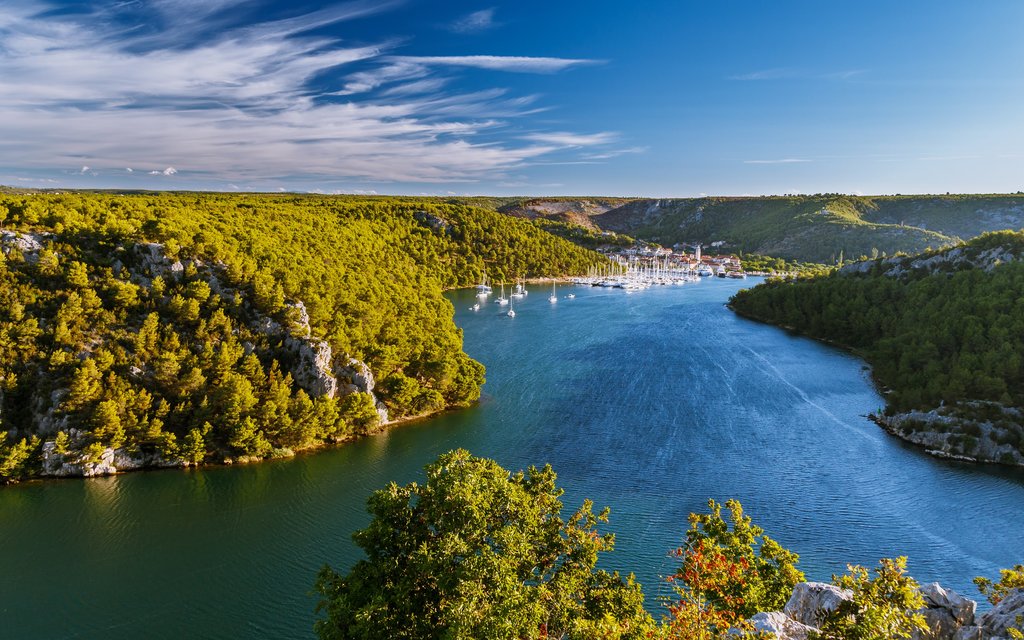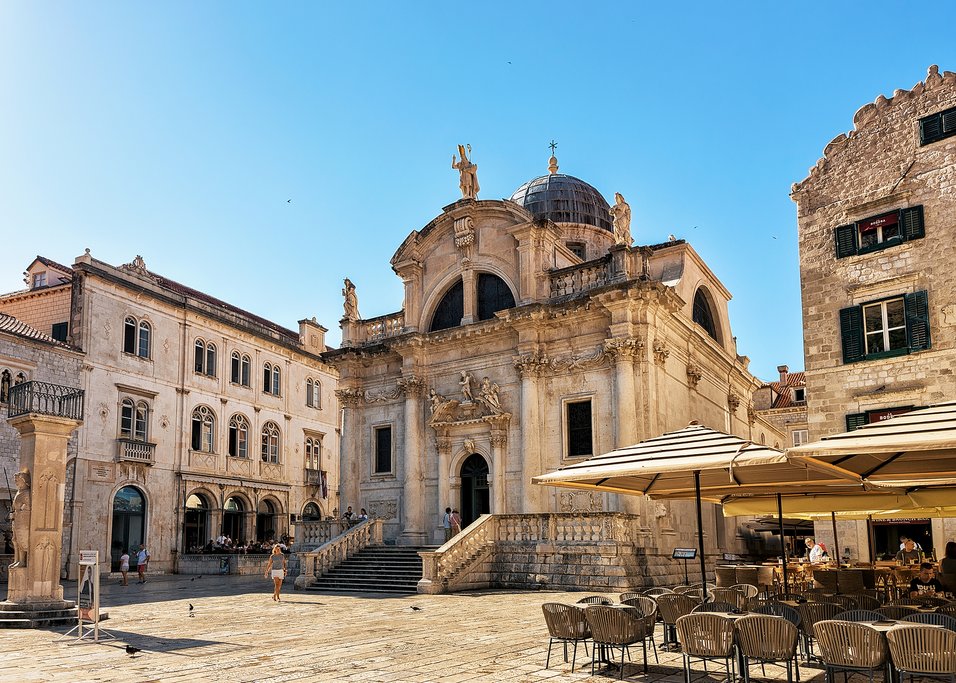Highlights
- Discover cascading waterfalls and emerald lakes in Plitvice Lakes National Park
- Walk Split's 1,700-year-old stone-paved streets, leftover from Roman times
- Drink Grk wine in Marco Polo's hometown on Korčula
- Feast on fresh-caught oysters & mussels in the Pelješac peninsula
- Watch the sunset over the Elafiti Islands from Srđ Mountain in Dubrovnik
Brief Itinerary
| Day | Highlights | Overnight |
|---|---|---|
| Day 1 | Welcome to Zagreb! | Zagreb |
| Day 2 | Zagreb to Plitvice Lakes National Park | Plitvice Lakes |
| Day 3 | Plitvice Lakes to Split, Stopping at Krka National Park | Split |
| Day 4 | Ferry from Split to Korčula | Korčula Town |
| Day 5 | Korčula to Dubrovnik via Pelješac Peninsula's Wine Region | Dubrovnik |
| Day 6 | Walking Tour of Dubrovnik | Dubrovnik |
| Day 7 | Depart Dubrovnik |
Detailed Itinerary
Day 1: Welcome to Zagreb!

Start your adventure from Zagreb, the capital of Croatia. Upon arrival at the airport, you'll be transferred to your hotel to settle in. The rest of the day is yours to spend as you like. The city center is easily walkable and the streets and parks are easy to navigate by foot. All the main attractions and restaurants are within walking distance.
A gem of a European city, Zagreb is at once historic and new. It's filled with leafy green parks and gothic/neo-renaissance buildings, yet there's also modern shopping complexes, outdoor malls, and endless dining and drinking options. Consider heading out on a guided walking tour of the historic heart of the city. This involves walking from the main square to Zagreb's Upper Town and passing through local markets before reaching St. Mark's Square.
Alternatively, you can visit one of the many museums and art galleries, like the Homeland War Museum, the Nikola Tesla Technical Museum, or the ever-popular Museum of Broken Hearts. Or stroll through the city center, enjoying 17th-century neo-baroque architecture found at Zagreb's Art Pavilion and Croatian National Theater.
Zagreb also has a number of beautiful city parks which are great for exploring and people watching, especially in the late afternoon. Maksimir is a great option, with a variety of cafés nearby to pick up a coffee for your stroll.
Day 2: Zagreb to Plitvice Lakes National Park

Today, you'll make the drive south to Plitvice Lakes National Park, one of Croatia's most popular national parks. Along the way, make a point to stop at Rastoke. Rastoke is a small village known for its old watermills and beautiful waterfalls as two rivers converge in the area. This is a nice precursor of the sights to come at Plitvice Lakes.
A short drive later, you'll arrive at Plitvice Lakes National Park in the early afternoon and can explore the park at your leisure. A must-visit for any traveler to Croatia, the UNESCO-protected park is comprised of an exquisite collection of 16 glassy emerald green and blue travertine lakes, more than 90 cascading waterfalls that seemingly cover every corner of the park, and numerous caves. The terraced lakes are surrounded by beech and pine forests and are home to extensive wildlife.
Choose one of eight different hiking trails, ranging from three to eight hours in duration, where the upper lakes tend to be less crowded during the peak season. You may wish to bring a bought lunch (and a bottle of wine!) with you to enjoy a picnic. Tickets are purchased at the entrance of the Park.
Driving time (Zagreb to Rastoke): 1.5-2 hours
Driving time (Rastoke to Plitvice): 30 minutes
Day 3: Plitvice Lakes to Split, Stopping at Krka National Park

Get an early start to your morning and make the trip south to Krka National Park, another of Croatia's top-rated parks home to a network of striking waterfalls. With seven waterfalls—the largest and most impressive being Skradinski Buk—Krka National Park is one of eight national parks in Croatia. The Krka River, another highlight of the park, carves through the limestone and creates a spectacular canyon on its 44-mile journey (70 km) from the foothills of the Dinaric Alps to Šibenik.
Follow the winding wooden paths that traverse emerald pools and river islands to prime lookout spots in which to view the falls. As if the stunning beauty of these falls isn't enough, you'll also be able to take a dip in one of the lagoons as Krka is the only national park in Croatia where swimming is allowed. Skradinski Buk is the final of the seven waterfalls, and mother nature saved the best for last. Cascading 78 feet (24 m) down into an emerald lagoon wider than the falls are tall, you'll find restaurants, snack stands, and ice cream shops at the base of this postcard locale to satisfy any food-related cravings.
Come mid-afternoon, travel further south to Split, settling into your hotel before taking the rest of the afternoon to wander its historic center.
Start at Pjaca Square for pretty views of white marble tiles, the Iron Gate (the western entrance to Diocletian's Palace), a Romanesque clock tower with the remains of a medieval sundial, and the 15th-century Town Hall. Stop for lunch at Trattoria Bajamont, just north of the Iron Gate. From there, visit the popular Voćni trg or Fruit Square. Here you can enjoy renaissance architecture, influenced during Split's Venetian era. For a bit of shopping and a bite to eat head to Marmont Street, though you'll want to head to the waterfront to catch the sunset.
In the evening, take a stroll along Split's seafront Riva to admire the waterfront views before finding the off-beat Konoba Dioklecijan restaurant, just to the left of the Bronze Gate for a bite to eat, its outdoor terrace built into the walls of Diocletian's Palace.
Driving time (Plitvice to Krka): 2 hours
Driving time (Krka to Split): 1-1.5 hours
Chat with a local specialist who can help organize your trip.
Day 4: Ferry from Split to Korčula

Take the morning to check out Split's Green Market (Pazar Market), a lively fruit and vegetable outdoor market just east of the Diocletian Palace. This is a great place to see how the locals shop and to pick up some fruit for your ferry ride to Korčula.
Once on Korčula, the afternoon and evening are yours to discover this little island's numerous restaurants, taverns, shops, and bars as you roam the maze of gray stone houses, alleys, churches, and squares.
Enjoy a traditional lunch of lamb and goat in Korčula's Old Town, one of the finest examples of Venetian architecture on the Dalmatian coast. Next, visit the 14th-century Land Gate on top of an elegant staircase, before heading to the St. Mark's Cathedral to admire its strange sculptures of beasts and people. Art enthusiasts will appreciate a visit to the Bishop's Treasury next door for a small but impressive art collection, including works from Carpaccio, Bassano, and Tiepolo. From there, you may wish to visit the unremarkable house thought to be the birthplace of Marco Polo.
If beaches are what you're after, rent a bike or scooter or ride the bus the 5 miles (8 km) to the sandy beaches of Lumbarda. Afterward, grab a bite to eat and pair it with the local dry white, Grk, indigenous to Lumbarda and nowhere else.
Ferry time (Split to Korčula): 4 hours
Day 5: Korčula to Dubrovnik via Pelješac Peninsula's Wine Region

Wave farewell to Korčula and make your way overland along the Pelješac Peninsula—home of Croatia's best-known red wines (Dingac and Postup). Should you choose, you can take a tour of one of the area's family-run wineries and sample Dingač's famous reds or opt to cycle along the Plavac Mali vineyards to a quiet bay for a swim, snorkel, and a lunch break.
After lunch, hop back into your private van and make your way to Ston—home of the longest fortified city walls on the continent (originally built to keep invaders away from the town's saltpans) and famous for its oysters and mussels. Take a walk on the walls before rewarding your efforts with a light meal of Ston's famous fresh oysters or mussels accompanied by a glass of local Dingač red wine.
When you're ready, make your way to the historic coastal fortress city of Dubrovnik. The early evening will be at your leisure, allowing time for you to wander and explore this magical city. You might like to consider finding your way to Buza Bar to enjoy a cocktail while taking in the sunset.
Ferry time (Korčula to Orebić): 30 minutes
Driving time (Orebić to Ston): 1 hour
Driving time (Ston to Dubrovnik): 1 hour
Day 6: Walking Tour of Dubrovnik

Start your day early (around 8 am) to avoid the crowds and to embark on a tour of Dubrovnik where you'll meet your expert guide outside the entrance to the medieval city at the 16th-century Pile Gate. Entering Old Town, you'll uncover centuries of the city's rich history as you listen to stories of local life and legends and of the importance Dubrovnik once held in the era of the Republic. Highlights include Onofrio's Fountain, the 15th century Rector's Palace, Luza Square, the Church of St. Blaise (St. Vlaho), and the café-lined streets of Brsalje Street.
After touring the streets and alleys, you'll head for Lovrijenac Fortress as well as the city's impressive defensive walls, the second-largest set of city walls in the world. At certain places the wall rises 75 feet high, offering excellent vantage points for photos of the coastline.
For the rest of the afternoon, explore Dubrovnik and its surroundings on your own or enjoy the afternoon sun on the nearby beaches. Come early evening, you can get stunning panoramic views over the city and Adriatic by taking the cable car up to Srđ Mountain before descending back down for dinner at one of Dubrovnik's great restaurants.
Day 7: Depart Dubrovnik

Depending on when you depart, you may have time to visit one of Dubrovnik's museums, like the Franciscan Monastery and Museum. This large complex houses many treasures, including the world's third oldest pharmacy dating from 1317.
Alternatively, for a collection of 15,000 pieces of interesting works, visit the Rector's Palace and Cultural Historical Museum. Wander this well-preserved palace-turned-museum and explore its exhibits, some detailing life in the Republic of Ragusa during medieval times.
The drive to the airport from Dubrovnik takes around 45 minutes with normal traffic.
